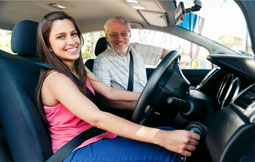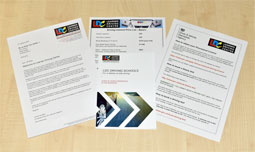Driving lesson 14. Progressive & Eco-safe driving
Introduction
Progressive driving is about making maximum progress for the road, traffic and weather conditions without risking safety. This requires more driving skill along with better planning and awareness, particularly when you are overtaking or negotiating bends in the road. Eco safe driving is very similar but with more emphasis on saving fuel.
Key learning notes
Progressive Driving
Speed versus Progress
There is one golden rule about speed - never drive beyond the limits of your vision - always drive at such a speed that you can stop safely within the distance you can see to be clear.
Speed does not necessarily equal progress. For example when you are proceeding in a constant flow of traffic that has few significant gaps there is little point in racing to overtake at every opportunity as your progress will continually be hindered by the overall flow of the traffic. You would be constantly slowing down and accelerating to save a few minutes out of a 60 minute journey time. The fuel you would use on such a journey would potentially be doubled and your energy would be sapped from all the extra concentration needed to cope with the overtaking and the constant changes of speed. Therefore the progressive driver uses his brain and does not waste fuel or energy for little or no gain in overall journey times. One extra stop for fuel would loose any gain you might make.
Keeping a grip
When driving at speed road and tyre adhesion become critical. Therefore anything that will influence this adhesion must be considered when you are driving. Tyre tread, tyre pressure and the cars suspension all affect the cars ability to stop or take corners at speed.
Changes in the road surface also play a major role. Wet leaves, mud, oil, ice and water on the surface of the road all affect adhesion as does the actual material make up of the road surface itself. Certain road surface materials give a better grip. Changes in the way the road inclines can also affect adhesion particularly on corners. All the above need to be carefully considered if you want to make maximum progress without compromising safety.
Driving round the bend
There is a lot of skill and balance needed to make maximum progress round bends. However, the first thing to remember is the golden rule. Just because you can take a bend at 50 mph doesn't mean that you should, especially, if you cannot see what's around the corner. You may discover a steam roller, a combine harvester or an articulated lorry waiting for you!
When approaching a bend you need to consider;
- The shape of the bend;
 What you can see ahead;
What you can see ahead;- What's on the road surface (and does it incline in any way)
- What you will hit if you lose control.
If there are trees along the road and you are pushing the car and/or your own ability to its limits then you are dicing with death. Bends take many "boy and girl racers" lives.
Balance - the first thing that you need to learn to successfully negotiate bends at speed is balance. The vehicle achieves maximum adhesion when the weight of the car is evenly spread over each wheel and across the whole of the tread of the tyres .
When steering:

When braking:

As soon as you brake or turn the weight of the car shifts so adhesion may primarily be occurring on only one or two of the tyres and, if the wheels lock, only across part of the tyres tread. This dramatically increases the risk of a skid (i.e. the loss of adhesion) and makes the car very unstable.
Therefore you should not be braking or accelerating at the point you enter the bend. Ideally you should maintain a constant speed into and around the bend. As you come out of the bend you can begin to accelerate.
Sensitivity - when you turn your steering wheel it should be done gradually and smoothly without jerking. You are trying to minimise the sharpness of the curve you are turning without cutting across to the other side of the road or allowing your road position to become a hazard to oncoming vehicles. On approach to the hazard (i.e. the bend) you should apply your hazard drill making sure you are at the correct speed and in the correct gear before you start to turn.
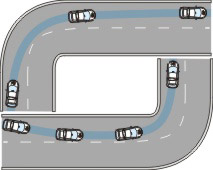
Overtaking at speed on single carriageways
Overtaking moving vehicles at speed on a single carriageway is potentially the most dangerous manoeuvre you can perform. You are driving on the wrong side of the road while traffic may be heading towards you.

Choose a safe place to overtake
Perhaps the most important thing to learn about overtaking is where not to overtake. You should never normally overtake immediately after a warning sign, in particular those shown below:
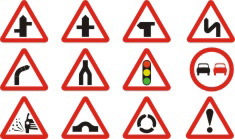
You need to look well ahead for these hazards and also for any road markings.

Dead ground
One physical hazard that is not easy to spot is something known as "Dead Ground". This is where the road dips into a hollow giving you the illusion that there are no oncoming vehicles when in fact there are.

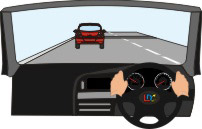
There are two important points to learn from this. Firstly, if your view ahead is not absolutely clear wait and secondly; always be prepared to abort the overtake, if necessary.
The overtaking procedure
The overtaking procedure is similar to that covered on the dual carriageway driving lesson, however, we now have to consider oncoming traffic. You would probably use the hazard drill at least three times as shown opposite.
Never "follow through"
You may occasionally find yourself in a stream of traffic all of which intend to overtake a slow moving vehicle. Make sure that you can see clearly ahead before overtaking in this situation. Never blindly follow the vehicle in front assuming that it is safe to overtake.
How to overtake
 P - move into the left hand lane without cutting in.
P - move into the left hand lane without cutting in.
S - cancel your signal.
M - check your mirrors to see what is following and ensure it is safe to move back into the left hand lane.
S & G - Speed up, especially if you had to reduce speed earlier.
P - Move your vehicle into the right hand lane while maintaining adequate clearance from the target vehicle.
S - Signal your intention to overtake.
M - Check your mirrors and glance to your right to ensure it is safe to continue with the overtake.
S & G - Adjust your speed to match that of the vehicle in front if it is not safe to proceed with the overtake or select the best gear for overtaking.
P - Maintain a safe distance behind the vehicle in front.
M - Check your mirrors well in advance for potential gaps behind.
Eco-safe driving
Eco-safe driving is a style of driving that will help to reduce damage to our planet and the air we breathe whilst improving road safety and saving you up to 15% on your fuel bill. Transport currently accounts for 20% of all air pollution emissions in the world.
Eco-safe driving is not about driving slowly (although this would undoubtedly help to reduce fuel consumption and accidents) it is more about avoiding senseless wastage of fuel through unnecessary acceleration or braking, inefficient use of the gears and speeding (i.e. exceeding permitted limits or driving at speeds unsafe for the prevailing conditions). The skills required for hazard perception, defensive driving and progressive driving play a big part in eco-safe driving as they will help you to avoid inefficient use of the accelerator, brake and gears through better awareness, anticipation and planning. There are four key aspects to being an eco-safe driver namely:
1. Minimise harsh or rapid acceleration
Whenever it is safe to do so, gradually increase speed by gently depressing the accelerator. Don't peak the revs on your rev counter, try to get them to grow steadily in line with your speed on your speedometer.
Don't accelerate unnecessarily. Look well ahead to see what is happening, to ensure that any acceleration now will not be wasted a little later on because you have to brake.
Let gravity aid you so that if you are going down hill you may find you can fully release pressure on the accelerator and still maintain a safe speed.
2. Minimise harsh braking or unnecessary stopping
Look well ahead and if you see that you will need to reduce speed, do it gradually using engine braking by simply releasing pressure on the accelerator rather than applying the brake at the last minute. Gradually adjust your speed to time your arrival at meet situations or when turning right such that you can potentially maintain progress and avoid having to stop. Similarly, you can do this when emerging from a give way junction provided you have a good view of the road you intend to emerge into as you approach the junction.
3. Engage higher gears as soon as possible without labouring the engine
Avoid engaging unnecessary intermediate gear changes so that you can more quickly engage higher gears or delay engaging lower gears. Modern cars are designed to deliver power even when engine revs are quite low and provided you haven't lost momentum as you slow down you will be surprised how late you can leave a downward gear change without risking an engine stall.
4. Avoid manoeuvring whilst the engine is cold if at all possible
Cold engines use more fuel. Do any manoeuvring before you get out of the vehicle rather then when you return to the vehicle (for example by reversing into parking places or driveways rather than reversing out). Not only does this save fuel, it is also a much safer way to emerge onto a road.
Finally, if you need to use a manual choke to start the vehicle, always remember to press it back in once the engine is sufficiently warm. Driving safety is paramount, so never sacrifice safety for fuel saving.
The above behaviours will not only save you fuel they will also save wear and tear on the cars engine, brakes and tyres thus saving you even more money. By driving less impulsively and continually planning ahead you will not only save money you will also become an even safer driver. So save money, save lives, save our planet - adopt an eco-safe style of driving.
Highway Code study
Rules: 103, 113 - 115, 121, 127 - 129, 154, 164 - 169, 274, 276 - 287.

